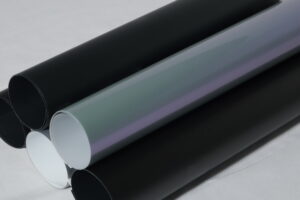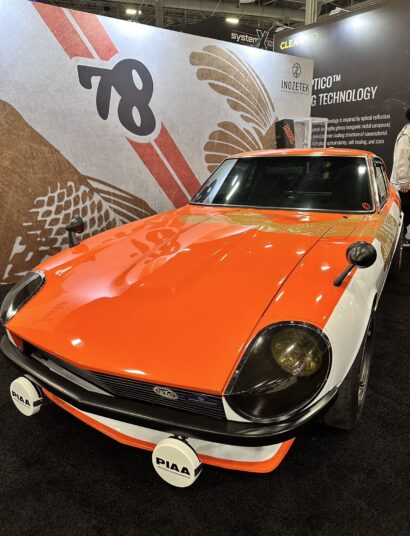10. 23. 2024
The Impact of Extreme weather conditions on PPF durability: A performance analysis

Imagine stepping out on a cold winter morning and finding your car covered in a thin layer of road salt and ice. This is a common sight in regions that have harsh winters. What does this mean to the paint protection film that protects your car? This question may have crossed your mind several times if you are like most car owners who take their vehicle’s safety seriously. We have investigated the issue to uncover the true effects extreme weather has on PPF.

Degradation of PPF during Extreme Weather
Over time, PPF can be significantly damaged by prolonged exposure to extreme temperatures and sunlight. Yellowing, peeling and reduced effectiveness are all possible issues. It is best to park in a shaded area or to use a carcover to protect the PPF against harsh weather conditions.
Impact of extreme weather on PPF
Extreme weather conditions can be a challenge for the PPF’s durability. Hailstorms can damage your vehicle’s paint as well as the PPF. Imagine small ice ball falling from the sky with high speed. It’s not surprising that they can cause significant damage to your vehicle’s outside. The PPF absorbs the hail impact that is intended for the paint on your vehicle.
PPF is also put under strain by heavy rain and snow. Moisture from rain can weaken adhesive properties, making the film more susceptible to peeling and bubbling. Snow and ice in regions that use road salt to de-ice the roads during the winter can contain corrosive substances which can damage the film. It is impossible to deny the relentless attack of these conditions on the exterior of your vehicle. PPF is a loyal protector who protects your vehicle from various environmental threats. Even the most powerful protector will need help when it comes to hailstorms, excessive water or snow. It is important to invest in high-quality PPF, which will protect your vehicle from nature’s harshest conditions.

Effects of UV Radiation On PPF
Imagine PPF as a shield protecting your vehicle’s finish. Imagine UV radiation trying to penetrate this shield. When UV rays are exposed to direct sunlight over an extended period, they can cause a number of detrimental changes to PPF. The yellowing and brittleness is one of the most obvious signs of UV exposure. It not only reduces the effectiveness of the film, but also its appearance. Even films with UV resistant top coats can degrade over time.
Understanding how different PPFs perform against UV radiation can be crucial. A high-quality PPF that has UV-resistant properties will block up to 95% of UV rays. This feature not only increases the lifespan of the film, but also protects the paint on the vehicle. PPFs that are formulated to resist high UV levels have a significant impact on the appearance and integrity of the exterior of a car.
It’s important to understand how strategic parking and regular inspections can help mitigate the harmful effects of UV radiation. You can minimize the harmful effects of UV radiation by proactively monitoring your PPF. The constant battle between UV radiation and PPF has significant consequences for the durability of the protective films and the aesthetic appeal on your vehicle.
Understanding these effects will help car owners protect their investment and ensure that their vehicle maintains its sleek look for many years.
Durability of PPF in heat and cold
Heat
Extreme temperatures can have a significant impact on the performance of Paint Protection Film (PPF). PPF softens when temperatures increase, making it more vulnerable to minor impacts. It is important to be aware that this vulnerability increases in high-temperature areas. Long-term exposure to high temperatures may also weaken the film’s adhesive properties, which can lead to edge lift, or the film peeling off at the edges. Its protective abilities and aesthetic appeal are compromised. If your car has been parked in extreme heat for a long time, the PPF will become more susceptible to being scratched by small stones or other debris. The increased air pressure as you drive off can further damage already weak adhesive.
Cold
PPF can become stiffer and more susceptible to cracking at extremely low temperatures. Cold temperatures cause the material to contract, which increases the likelihood of it tearing. This is especially true around corners and edges. Extreme heat and cold can cause damage to your PPF. The film will contract and expand frequently in areas where there are significant temperature changes, which puts additional stress on the material as well as the adhesive. Understanding how temperature fluctuations affect the PPF’s longevity is important for regions that experience frequent and dramatic temperature changes.
Material Quality vs. Weather Resistance
PPF’s ability to resist environmental stress is largely determined by the quality of material it uses. Leading brands have set industry standards with multi-layer constructions which offer superior resistance to extreme weather conditions. These advanced constructions have been designed to provide optimal performance and longevity despite different environmental impacts.
PPF of higher quality is usually thicker and provides enhanced durability to physical impacts, such as road debris, rocks, and gravel. This thicker film creates a strong shield to protect your car paint from the harsh weather and everyday commutes. Premium films are enhanced by the use of top coats that offer superior scratch and UV resistance. However, low-quality films are more likely to show signs of wear, such as peeling and yellowing. They also lose their transparency faster. These problems not only reduce the aesthetic appeal of your car, but also the protective abilities of the film.
PPFs that are not up to par may fail in extreme weather conditions. This leaves your vehicle’s paint susceptible to UV rays, environmental pollutants, and other damage. It’s like comparing an umbrella that is too thin to one that is sturdy during a storm. The difference is huge. A high-quality PPF will not only protect your vehicle for a long time, but it also gives you peace of mind when weather conditions are challenging. Premium PPF materials are durable and resilient, protecting your vehicle from harsh elements and climate conditions.
Conclusion
In evaluating extreme weather’s impact on PPF durability it is important to consider the quality of the material. By investing in high-quality PPF, you can ensure that your vehicle will maintain its pristine look while protecting it from unpredictable environmental challenges. You are investing in your vehicle’s appearance by carefully choosing a paint-protection film. But you are also protecting it from the forces of nature.

Performance Long-Term in Adverse Conditions
Extreme weather conditions have a significant impact on paint protection. Paint protection film has been proven to provide a strong defense against road debris and rocks. However, its durability in harsh weather conditions over time is also important. Imagine a car covered in PPF that is exposed to intense sunlight, heavy rains, snow and varying temperatures. How would the film perform under these conditions?
Installation and Maintenance Quality
For the PPF to last in adverse weather conditions, it is important that you maintain your PPF properly and install it correctly. Regular inspections in extreme weather conditions allow for the detection of minor damage and the correction before it becomes more serious. This can significantly extend the life span of PPF. With proper care, a high-quality PPF film can last 3-7 years in harsh conditions. Lower-quality films, however, may only last 1 to 2 years because of differences in the material composition, thickness and overall durability.
Cleaning Habits
The performance and longevity of PPF are also affected by regular cleaning habits. To maintain the film’s integrity over time, it is important to use pH-neutral cleaning products and avoid harsh chemicals. This will prevent premature degradation due to chemical reactions between aggressive cleaning agents. Driving habits are just as important as cleaning and inspections. If your vehicle is heavily used, or exposed to extreme conditions frequently, you may need to perform more frequent maintenance and checks to maintain the film’s functionality. These factors should be considered in the maintenance schedule of car owners to protect their investment.
Driving Habits and Exposure to Environmental Hazards
It’s important to take into account several factors when examining the lifespan of PPF. These include driving habits and exposure to environmental conditions. In general, vehicles driven in urban areas are exposed to less severe weather than those in rural or coastal areas. The PPF is less likely to be damaged by harsh elements like gravel, salt and other debris that are often found on rural roads and near coastal areas.
The environmental exposure is a key factor in determining the durability of PPF. Extreme weather conditions such as heavy rain, snow or prolonged exposure to intense sun can cause the film to wear out faster. Due to prolonged exposure to the sun, vehicles that are exposed to high UV levels may see a faster degradation of their PPF. Hailstorms and abrasive roads can also cause the film to deteriorate prematurely in regions with frequent hailstorms.

Routine Maintenance
It is equally important to maintain a regular maintenance schedule in order to extend the life of your PPF. Cleaning and caring for the film regularly not only improves its aesthetic appeal, but also increases its durability. In order to avoid abrasion and damage to the surface of the film, it is important to use gentle cleaning solutions with microfiber cloths. Premium PPF options are often backed by warranties of up to 10 year, demonstrating their confidence in the product’s durability and performance.
Leading Paint Protection Film Solutions by RCWRAP
RCWRAP offers the best paint protection films to protect your vehicle. Our technicians will use the latest technology to protect your vehicle from environmental damage and scratches. This will ensure a long-lasting appearance and durability. You can be confident that we will protect your car to the highest standard possible. Visit RCWRAP to purchase premium paint protection for your vehicle. Click here to start!
Understanding the impact of extreme weather on PPF, and the factors that affect its durability can help vehicle owners make informed decisions about protecting their investment. By carefully considering these factors, individuals can take proactive measures to protect their vehicles and prolong the life of their PPF.
Social Share:



No Comment Yet! You can post first response comment.